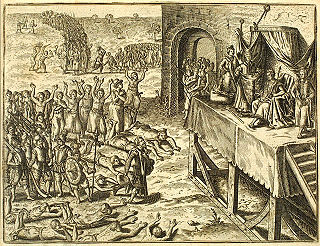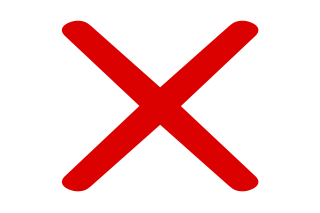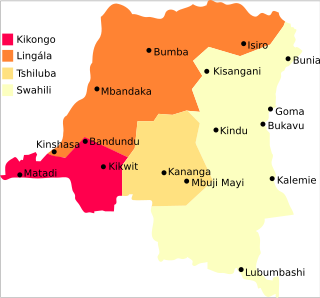
The economy of the Democratic Republic of the Congo has declined drastically around the 1980s, despite being home to vast potential in natural resources and mineral wealth; their gross domestic product is $48.994 billion as of 2019.

Pope Alexander III, born Roland, was head of the Catholic Church and ruler of the Papal States from 7 September 1159 until his death in 1181.

Brazzaville is the capital and largest city of the Republic of the Congo. Constituting the financial and administrative centre of the country, it is located on the north side of the Congo River, opposite Kinshasa, the capital city of the Democratic Republic of the Congo.

The Democratic Republic of the Congo (DRC), also known as Congo-Kinshasa and formerly known as Zaire, is a country in Central Africa bordered to the west by the South Atlantic Ocean. By land area, the DRC is the second-largest country in Africa and the 11th-largest in the world. With a population of around 112 million, the Democratic Republic of the Congo is the most populous officially Francophone country in the world. The national capital and largest city is Kinshasa, which is also the nation's economic center. The country is bordered by the Republic of the Congo, Central African Republic, South Sudan, Uganda, Rwanda, Burundi, Tanzania, Zambia, Angola, and the Cabinda exclave of Angola.

Manuel Luis Quezon y Molina,, also known by his initials MLQ, was a Filipino lawyer, statesman, soldier, and politician who served as president of the Commonwealth of the Philippines from 1935 until his death in 1944. He was the first Filipino to head a government of the entire Philippines, and is considered to have been the second president of the Philippines, after Emilio Aguinaldo (1899–1901), whom Quezon defeated in the 1935 presidential election.

The Manikongo, or Mwene Kongo, was the title of the ruler of the Kingdom of Kongo, a kingdom that existed from the 14th to the 19th centuries and consisted of land in present-day Angola, Gabon, the Republic of the Congo and the Democratic Republic of the Congo. The manikongo's seat of power was Mbanza Kongo, now the capital of Zaire Province in Angola. The manikongo appointed governors for the provinces of the Kingdom and received tribute from neighbouring subjects.

The Congo Basin is the sedimentary basin of the Congo River. The Congo Basin is located in Central Africa, in a region known as west equatorial Africa. The Congo Basin region is sometimes known simply as the Congo. It contains some of the largest tropical rainforests in the world and is an important source of water used in agriculture and energy generation.

The Kingdom of Kongo was a kingdom located in Central Africa in present-day northern Angola, the western portion of the Democratic Republic of the Congo, and the Republic of the Congo. At its greatest extent it reached from the Atlantic Ocean in the west to the Kwango River in the east, and from the Congo River in the north to the Kwanza River in the south. The kingdom consisted of several core provinces ruled by the Manikongo, the Portuguese version of the Kongo title Mwene Kongo, meaning "lord or ruler of the Kongo kingdom", but its sphere of influence extended to neighbouring kingdoms, such as Ngoyo, Kakongo, Loango, Ndongo, and Matamba, the latter two located in what is Angola today.

The coat of arms of Portugal is the main heraldic insignia of Portugal. The present model was officially adopted on 30 June 1911, along with the present model of the Flag of Portugal. It is based on the coat of arms used by the Portuguese Kingdom since the Middle Ages. The coat of arms of Portugal is popularly referred as the Quinas.

The Democratic Republic of the Congo is a multilingual country where an estimated total of 242 languages are spoken. Ethnologue lists 215 living languages. The official language, inherited from the colonial period, is French. Four other languages, three of them indigenous, have the status of national language: Kikongo, Lingala, Swahili and Tshiluba.
The Province of the Anglican Church of the Congo is a province of the Anglican Communion, stretching over the Democratic Republic of the Congo and the Republic of the Congo.

Corruption in the Democratic Republic of the Congo, which used to be an institutionalized part of the state, has been relatively lowered in recent years. However, it continues to exceed corruption in comparison to most states. The BBC's DRC country profile calls its recent history "one of civil war and corruption." President Joseph Kabila established the Commission of Repression of Economic Crimes upon his ascension to power in 2001.

The Republic of the Congo, also known as Congo-Brazzaville, the Congo Republic or simply either Congo or the Congo, is a country located on the western coast of Central Africa to the west of the Congo River. It is bordered to the west by Gabon, to its northwest by Cameroon and its northeast by the Central African Republic, to the southeast by the Democratic Republic of the Congo, to its south by the Angolan exclave of Cabinda and to its southwest by the Atlantic Ocean.
The Democratic Republic of the Congo was a net energy exporter in 2008. Most energy was consumed domestically in 2008. According to the IEA statistics the energy export was in 2008 small and less than from the Republic of Congo. 2010 population figures were 3.8 million for the RC compared to CDR 67.8 Million.

Visitors to the Democratic Republic of the Congo must obtain a visa from one of the Democratic Republic of the Congo diplomatic missions unless they come from a visa exempt country, a country whose nationals can obtain a visa on arrival or eligible to obtain an e-visa online https://evisa.gouv.cd or are arriving from a country with no embassy, in which case they can obtain a visa confirmation followed by a 7-day visa on arrival. In recent years, it is possible to arrange a tourist visa for visiting the Virunga National Park through the park itself.
Henrique III Mpanzu a Nsindi a Nimi a Lukeni was ruler of the Kingdom of Kongo from the Kivuzi branch of the Kinlaza house, who reigned from 1840 until 1857. Henrique came to power when he overthrew his predecessor, André II. This was with the support of the elector Ntinu Nsaku. Henrique did not manage to kill Andre II and King Andre continued to exercise power from Mbanza Maputu over some of the Kongo realm.
Relations between the Congo Free State and the United States began after recognition between the two states in 1885 when the Congo Free State was established. After Belgium under Leopold II annexed the Congo Free State in 1908, later becoming Belgian Congo, relations ceased between the two nations.











